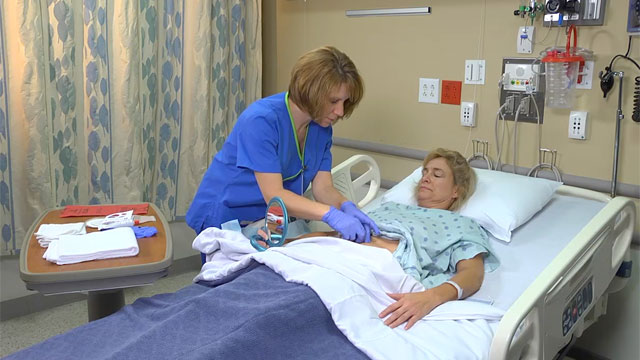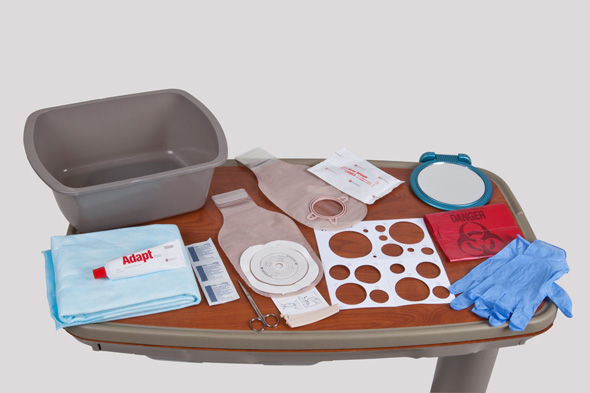Ostomy Care
Select a Skill:
Take the Review Test:

Safety
- To avoid leakage, which can cause chemical or enzymatic injury to the skin, change or empty the ostomy pouch before it becomes full.
- To minimize skin irritation, avoid changing the entire pouching system unnecessarily.
- Wear a gown or goggles if splashing is a risk when emptying a colostomy pouch.
- To reduce exposure to and transmission of infectious microorganisms, wear gloves during pouch and stoma care.
- Know the signs of a healthy stoma and peristomal skin:
- Color/moisture: The stoma should be red or pink and moist. If it is gray, purple, or black, report this to the charge nurse or to the health care provider.
- Size: The stoma will probably decrease in size in the 4 to 6 weeks after surgery. Measure the stoma with each pouch change.
- Appearance: Peristomal skin is normally intact, with some redness and light bleeding occurring when gently washed. Blisters, or a rash and a raw appearance, are abnormal. A necrotic stoma is purple or black, dry instead of moist, does not bleed when washed gently, or has tissue sloughing. If you observe any of these signs, report the finding to the charge nurse or to the health care provider.
- Teach patients the significance and importance of drinking 1.4 to 1.8 L of fluid daily, unless contraindicated, to prevent dehydration.
Equipment
(Roll cursor over items to see labels)

Skin barrier/pouch
Skin barrier/pouch
Pouch closure device, such as a clip, if needed
Ostomy measuring guide
Clean gloves
Disposable waterproof pad
Basin
Scissors
Adhesive remover (optional)
Biohazard bag for pouch disposal
Hand mirror (optional)
Delegation
The skill of pouching a new ostomy cannot be delegated to nursing assistive personnel (NAP). In some agencies, care of an established ostomy (4 weeks postoperative or more) can be delegated to NAP. Be sure to inform NAP of the following:
- Review the expected amount, color, and consistency of drainage from the ostomy.
- Describe the expected appearance of the stoma.
- Specify any special equipment needed to complete the procedure.
- Identify changes in the patient’s stoma and surrounding skin integrity that should be reported.
Preparation
- Perform hand hygiene and apply gloves.
- Observe the existing skin barrier and pouch for leakage; note the length of time in place. Change the skin barrier/pouch every 3 to 7 days for a colostomy, not daily. If the pouch is opaque, remove it to fully observe the stoma.
- Observe the amount of effluent in the pouch, and empty the pouch if it is more than one-third to one-half full. To do so, open the clip and drain it into a container to measure the output. Note the consistency of the effluent, and record the amount.
- Observe the type, location, and color of the stoma. Note any swelling and the presence of any sutures. Look for evidence of trauma, healing, or irritation of the peristomal skin. Remove and dispose of your gloves.
- Observe the abdomen to determine the best type of pouching system. Consider the contour of the abdomen and the presence of scars or incisions.
- Explore the patient’s attitude toward learning self-care; identify others who will be assisting the patient after he or she is discharged.
- Explain the procedure, and encourage the patient’s interaction and questions.
Follow-up
- Observe the condition of the skin barrier and its adherence to the abdominal skin.
- During the pouch change, observe the appearance of the stoma and the peristomal skin. Note the contours of the abdomen and the condition of the suture line.
- Observe the patient’s and the caregiver’s willingness to view the stoma and to ask questions about the procedure.
Documentation
- Record the following:
- Type of pouch and skin barrier applied
- Amount and appearance of the effluent in the pouch
- Size and appearance of the stoma
- Condition of the peristomal skin
- Record the patient’s and family’s level of participation. Record the teaching provided and the response to it.
- Report any of the following to the charge nurse or to the health care provider:
- Abnormal appearance of the stoma
- Abnormal appearance of the suture line, the peristomal skin, or the character of the output
Review Questions
1. What is the nurse’s initial action when preparing to change a patient’s colostomy pouching system?
 Applying clean gloves
Applying clean gloves Draping the patient appropriately
Draping the patient appropriately Emptying the colostomy
Emptying the colostomy Assessing the surrounding skin for signs of irritation.
Assessing the surrounding skin for signs of irritation.
2. When pouching a patient’s colostomy, which action reduces the patient’s risk for injury?
 Measuring output when emptying the contents of the pouch
Measuring output when emptying the contents of the pouch Maintaining the patient’s bowel elimination function
Maintaining the patient’s bowel elimination function Promoting the patient’s autonomy with bowel elimination care
Promoting the patient’s autonomy with bowel elimination care Protecting the skin from irritation caused by fecal drainage
Protecting the skin from irritation caused by fecal drainage
3. When changing the pouching system, which routine step best minimizes irritation of the skin surrounding the stoma?
 Using adhesive remover
Using adhesive remover Emptying the ostomy bag only when full
Emptying the ostomy bag only when full Avoiding unnecessary changes of the pouching system
Avoiding unnecessary changes of the pouching system  Wearing clean gloves
Wearing clean gloves
4. Which initial nursing action would best help the patient learn self-care of a colostomy pouching system?
 Giving the patient handouts on self care of a colostomy
Giving the patient handouts on self care of a colostomy Allowing the patient to examine an ostomy device
Allowing the patient to examine an ostomy device  Identifying a family member who can participate in the ostomy appliance process
Identifying a family member who can participate in the ostomy appliance process  Giving the patient a mirror to watch the nurse provide care
Giving the patient a mirror to watch the nurse provide care
5. Which instruction might the nurse give to nursing assistive personnel (NAP) regarding the care of a patient with a newly established colostomy?
 “Be sure to pat-dry the skin surrounding the stoma before applying the new pouch.”
“Be sure to pat-dry the skin surrounding the stoma before applying the new pouch.” “Alert me immediately if you see any blood in the fecal matter in the pouch.”
“Alert me immediately if you see any blood in the fecal matter in the pouch.” “Using the stoma guide, cut the pouch opening about one-eighth of an inch bigger than the stoma.”
“Using the stoma guide, cut the pouch opening about one-eighth of an inch bigger than the stoma.” “Remember to change your gloves after cleaning the stoma and the surrounding skin.”
“Remember to change your gloves after cleaning the stoma and the surrounding skin.”
You have completed the Review Questions for this skill. To take the Review again select the Start Over button. To proceed to another skill select from the dropdown menu. Select the Home or Back button to proceed to the next section.

